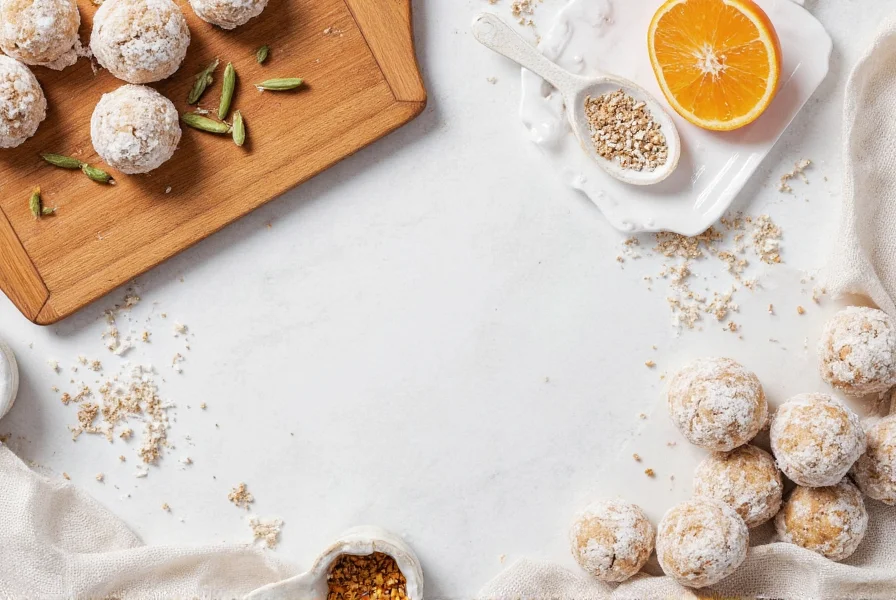For baking enthusiasts seeking to perfect this unique flavor combination, understanding the science behind the orange-cardamom pairing is essential. Cardamom, one of the world's oldest spices, contains compounds that complement citrus notes while adding depth. When paired with orange, the resulting cookies achieve a sophisticated balance between bright acidity and warm spice that ordinary sugar cookies lack.
The Perfect Flavor Balance
Creating exceptional orange cardamom cookies requires attention to ingredient ratios and preparation methods. Unlike many spice-cookie combinations, cardamom's potency means it can easily overwhelm delicate orange notes if not measured precisely. Professional bakers recommend using freshly ground cardamom seeds rather than pre-ground powder for maximum flavor impact.
| Ingredient | Traditional Amount | Critical Function |
|---|---|---|
| Fresh orange zest | 2-3 tablespoons | Provides bright citrus oils without liquid content |
| Freshly ground cardamom | 1.5-2 teaspoons | Delivers complex floral notes without bitterness |
| Unsalted butter | 1 cup (softened) | Carries fat-soluble flavor compounds effectively |
| Flour | 2.5 cups | Provides structure while absorbing citrus oils |
Step-by-Step Baking Guide
Follow these professional techniques for perfect orange cardamom cookies every time:
- Prepare fresh ingredients - Zest organic oranges before juicing, and grind cardamom seeds just before baking
- Cream butter and sugar - Beat until light and fluffy (5-7 minutes) to incorporate air for tender texture
- Incorporate citrus oils - Mix orange zest into sugar first to release maximum flavor compounds
- Chill dough properly - Refrigerate for at least 2 hours to prevent excessive spreading
- Bake at precise temperature - 350°F (175°C) for 10-12 minutes for optimal texture

Common Baking Challenges and Solutions
Many home bakers encounter specific issues when making orange cardamom cookies. Understanding these challenges helps achieve professional results:
- Flat cookies - Usually caused by insufficient chilling time or butter that's too soft. Solution: Chill dough for 3+ hours and use butter at exactly 65°F (18°C)
- Bland flavor - Often results from using dried zest or pre-ground cardamom. Solution: Always use fresh ingredients and grind cardamom seeds immediately before baking
- Overpowering spice - Cardamom can dominate if measured incorrectly. Solution: Start with 1 teaspoon cardamom per cup of flour and adjust in subsequent batches
- Dry texture - Typically from overbaking or incorrect flour measurement. Solution: Use spoon-and-level method for flour and remove cookies when edges are set but centers appear slightly underdone
Cultural Context and Variations
Orange cardamom cookies have roots in Scandinavian baking traditions, where cardamom has been prized since the 14th century. In Sweden and Norway, these cookies often appear during kräftskiva (crayfish parties) and holiday celebrations. Modern variations include:
- Gluten-free adaptation - Substitute 1:1 gluten-free flour blend and add 1/4 teaspoon xanthan gum
- Vegan version - Use plant-based butter and flax eggs with additional orange extract
- Chocolate-dipped - Dip cooled cookies in dark chocolate for complementary bitter notes
- Tea-pairing edition - Add a pinch of Earl Grey tea leaves to enhance the citrus-spice profile

Serving and Storage Recommendations
For optimal flavor development, allow orange cardamom cookies to rest for 24 hours after baking before serving. The flavors meld beautifully during this resting period. Store in an airtight container with a slice of apple to maintain softness for up to 5 days, or freeze for up to 3 months. These cookies pair exceptionally well with black tea, coffee, or aquavit for an authentic Scandinavian experience.
Frequently Asked Questions
Can I use orange extract instead of fresh zest in cardamom cookies?
While fresh zest provides superior flavor, you can substitute 1 teaspoon of pure orange extract for the zest of one medium orange. However, avoid artificial extracts as they create an off-flavor that competes with cardamom's delicate notes.
Why do my orange cardamom cookies spread too much during baking?
Excessive spreading typically occurs when butter is too warm or dough hasn't been chilled sufficiently. For best results, chill dough for at least 2 hours (preferably overnight) and bake on cool baking sheets. Using European-style butter with higher fat content also helps maintain cookie shape.
What's the difference between green and black cardamom for baking cookies?
Green cardamom (Elettaria) offers the classic citrusy, floral notes perfect for sweet baking, while black cardamom (Amomum) has a smoky, camphorous flavor unsuitable for cookies. Always use green cardamom pods for orange cardamom cookies, grinding the seeds just before use for maximum aroma.
How can I intensify the orange flavor in cardamom cookies without making them bitter?
To enhance orange flavor without bitterness, use only the colored zest (avoiding the white pith), incorporate 1/2 teaspoon of orange blossom water, and let the dough rest 24 hours before baking. The resting period allows flavors to meld while reducing any harsh notes from the citrus oils.











 浙公网安备
33010002000092号
浙公网安备
33010002000092号 浙B2-20120091-4
浙B2-20120091-4